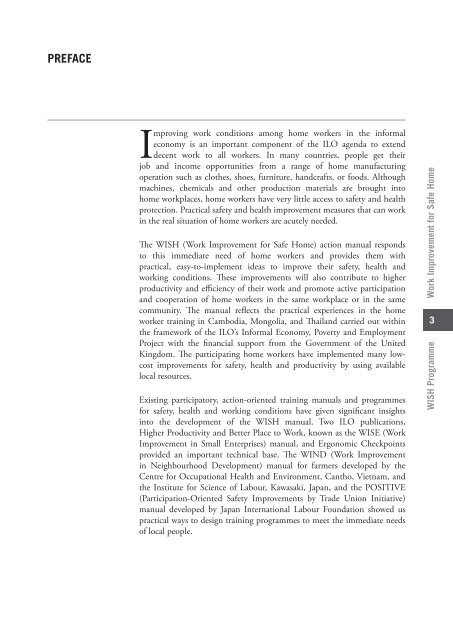Work Improvement for Safe Home - International Labour Organization
Work Improvement for Safe Home - International Labour Organization
Work Improvement for Safe Home - International Labour Organization
Create successful ePaper yourself
Turn your PDF publications into a flip-book with our unique Google optimized e-Paper software.
PREFACE<br />
Improving work conditions among home workers in the in<strong>for</strong>mal<br />
economy is an important component of the ILO agenda to extend<br />
decent work to all workers. In many countries, people get their<br />
job and income opportunities from a range of home manufacturing<br />
operation such as clothes, shoes, furniture, handcrafts, or foods. Although<br />
machines, chemicals and other production materials are brought into<br />
home workplaces, home workers have very little access to safety and health<br />
protection. Practical safety and health improvement measures that can work<br />
in the real situation of home workers are acutely needed.<br />
Th e WISH (<strong>Work</strong> <strong>Improvement</strong> <strong>for</strong> <strong>Safe</strong> <strong>Home</strong>) action manual responds<br />
to this immediate need of home workers and provides them with<br />
practical, easy-to-implement ideas to improve their safety, health and<br />
working conditions. Th ese improvements will also contribute to higher<br />
productivity and effi ciency of their work and promote active participation<br />
and cooperation of home workers in the same workplace or in the same<br />
community. Th e manual refl ects the practical experiences in the home<br />
worker training in Cambodia, Mongolia, and Th ailand carried out within<br />
the framework of the ILO’s In<strong>for</strong>mal Economy, Poverty and Employment<br />
Project with the fi nancial support from the Government of the United<br />
Kingdom. Th e participating home workers have implemented many lowcost<br />
improvements <strong>for</strong> safety, health and productivity by using available<br />
local resources.<br />
Existing participatory, action-oriented training manuals and programmes<br />
<strong>for</strong> safety, health and working conditions have given signifi cant insights<br />
into the development of the WISH manual. Two ILO publications,<br />
Higher Productivity and Better Place to <strong>Work</strong>, known as the WISE (<strong>Work</strong><br />
<strong>Improvement</strong> in Small Enterprises) manual, and Ergonomic Checkpoints<br />
provided an important technical base. Th e WIND (<strong>Work</strong> <strong>Improvement</strong><br />
in Neighbourhood Development) manual <strong>for</strong> farmers developed by the<br />
Centre <strong>for</strong> Occupational Health and Environment, Cantho, Vietnam, and<br />
the Institute <strong>for</strong> Science of <strong>Labour</strong>, Kawasaki, Japan, and the POSITIVE<br />
(Participation-Oriented <strong>Safe</strong>ty <strong>Improvement</strong>s by Trade Union Initiative)<br />
manual developed by Japan <strong>International</strong> <strong>Labour</strong> Foundation showed us<br />
practical ways to design training programmes to meet the immediate needs<br />
of local people.<br />
<strong>Work</strong> <strong>Improvement</strong> <strong>for</strong> <strong>Safe</strong> <strong>Home</strong><br />
3<br />
WISH Programme

















